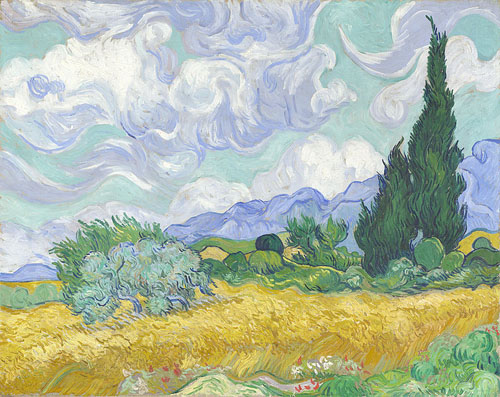Dear Friends,
Tangents:
VAN GOGH BLOOMS
With the help of 8,000 potted plants, Van Gogh’s A Wheatfield with Cypresses has been re-created on the western side of London’s National Gallery as part of its carbon-reduction plan. The living painting is part of a General Electric/National Gallery collaboration and will keep growing until October – there’s still time to see it. for a view of the “living wall” go to www.gereports.com/van-gogh-ecomagination-style/.
The idea of living walls has really been catching on in lots of cities (including Vancouver)– amazing to see, just a spectacular concept I think.

…and as for back to school, the sentiments expressed in this poem stir nostalgia,
ATLANTIC FAREWELL
All summer she saved us
from the heat’s languor
with shuddering cold mirth,
then sent us squealing
with delight to snuggle
warm sand valleys until
we called for mercy again.
We leave reluctantly
as gulls wipe our salty
tears from the rocks.
-Elizabeth Mata
Photos of the day
September 6, 2011

People painted with black grease celebrate during the traditional festivities of the Cascamorras festival, in the streets of Baza, Granada, Spain. According to an ancient tradition, the people from Baza try to stain with grease the Cascamorras, a man coming from the nearby village of Guadix to steal the statue of the Virgin of Mercy. He can only recover the statue if he gets there clean, something that has never happened in the five centuries of the ritual. Daniel Tejedor/AP

Labrador ‘Mara’ is shampooed as she sits in Germany’s first dog wash station in the dog Boutique ‘Dog an der Koe’ in Leipzig, central Germany. Jens Meyer/AP
Market Commentary:
Canada
By Matt Walcoff
Sept. 6 (Bloomberg) — Canadian stocks fell for a third day, led by financial and energy companies, after a state election setback for German Chancellor Angela Merkel’s party fueled concern that the European debt crisis will worsen.
Royal Bank of Canada, Canada’s largest lender by assets, dropped 1.5 percent as Greek bond yields climbed to a euro-era record. Suncor Energy Inc., the country’s biggest oil and gas producer, slid 2.4 percent as crude futures slipped 0.5 percent in New York. Barrick Gold Corp., the world’s largest producer of the metal, advanced 2.3 percent.
The Standard & Poor’s/TSX Composite Index decreased 83.87 points, or 0.7 percent, to 12,518.54.
“It’s how long do the Germans want to continue bailing out the Greeks or the Portuguese?” Philip Petursson, managing director of the Portfolio Advisory Group at Manulife Financial Corp.’s asset-management unit in Toronto, said in a telephone interview. The unit oversees $217 billion. “The markets just want to know someone is in control of the situation, and apparently, now no one is in control, whether it’s the U.S. economic situation, the U.S. debt situation, European debt, the global economy.”
The index slipped 1.3 percent during the previous two days, including a 0.7 percent drop on Sept. 2 after a U.S. government report showed employers added no jobs in August. The Canadian stock benchmark has fallen 6.9 percent this year as energy, base-metals and insurance stocks have dropped on concern over the European debt crisis and signs of a slowing global recovery.
Bond yields in the most-heavily indebted European Union countries surged after Merkel’s party suffered its fifth election loss this year on Sept. 4 as she failed to sway voters in her home state with a campaign based on her handling of the euro-area debt crisis. Canadian markets were closed yesterday for the Labor Day holiday.
S&P/TSX financial companies declined after rallying 2.2 percent last week. Royal Bank lost 1.5 percent to C$48.22.
Toronto-Dominion Bank, its biggest domestic rival, slipped 0.8 percent to C$76.56. Bank of Nova Scotia, Canada’s third-largest lender by assets, decreased 1.4 percent to C$52.30.
Crude oil retreated after sliding 2.8 percent Sept. 2. Suncor fell 2.4 percent to C$29.28. Bankers Petroleum Ltd., which operates in Albania, slumped 5.5 percent to C$4.64.
Encana Corp., the country’s largest natural gas producer, tumbled 4.7 percent to C$23.37 after Andrew Potter, an analyst at Canadian Imperial Bank of Commerce, cut his price estimate on its U.S.-traded shares to $32 from $38.
Oil and gas explorer Open Range Energy Corp. soared 40 percent to a record C$8.95 after saying it will spin off its services and supply business into a new company.
The S&P/TSX Gold Index closed at a record high as the metal rallied as much as 2.5 percent before erasing its gains.
Barrick Gold Corp., the world’s largest gold producer, gained 2.3 percent to C$53.15 after Peter Ward, an analyst at Jefferies Group Inc., began coverage of the company with a “buy” rating. In a note to clients, Ward cited the company’s July purchase of Equinox Minerals Ltd.
European Goldfields Ltd., which operates in southern Europe, advanced 5.1 percent to C$12.66. Centerra Gold Inc., which mines in Kyrgyzstan and Mongolia, jumped 10 percent to a record C$23.12 after being featured in a technical-analysis story in the Globe & Mail.
Harry Winston Diamond Corp., the co-owner of the Diavik mine featured in the TV series “Ice Road Truckers,” increased 6.4 percent to C$15.03. The company is scheduled to report second-quarter financial results tomorrow.
First Quantum Minerals Ltd., Canada’s second-largest publicly traded copper producer, retreated 3 percent to C$22.03 a day after Anindya Mohinta, an analyst at Citigroup Inc., cut his rating on the company to “hold” from “buy.”
SNC-Lavalin Group Inc. slumped 4.5 percent to C$48.57. Police raided one of the construction company’s Canadian offices as part of probe related to Bangladeshi government contracts, according to the Canadian Press.
BlackBerry maker Research In Motion Ltd. climbed 3.5 percent to C$30.63. Gus Papageorgiou, an analyst at Scotiabank, raised his rating on the shares to “sector outperform” from “sector perform” in a note dated yesterday.
Directory publisher Yellow Media Inc. plunged 12 percent to 79 Canadian cents after saying its chief financial officer, Christian M. Paupe, will leave the company. Shares of the Montreal-based company have sunk 87 percent this year.
US
By Rita Nazareth
Sept. 6 (Bloomberg) — U.S. stocks fell, giving the Standard & Poor’s 500 Index its longest slump in almost a month, amid concern that Europe’s debt crisis is worsening. Equities pared losses in the final 30 minutes of trading.
The benchmark measure trimmed its drop from 2.9 percent as companies most-tied to economic growth rebounded, propelling the Morgan Stanley Cyclical Index to a 0.2 percent gain for the day.
Bank of America Corp. and JPMorgan Chase & Co. decreased more than 3.4 percent on concern about a global financial crisis. Exxon Mobil Corp. and Alcoa Inc. lost at least 1.3 percent on speculation that demand for commodities will slow.
The S&P 500 lost 0.7 percent to 1,165.24 at 4 p.m. in New York. The benchmark gauge has fallen 4.4 percent in three days, the longest drop since Aug. 8. The Dow Jones Industrial Average slumped 100.96 points, or 0.9 percent, to 11,139.30 today.
“The big worry is the situation in Europe,” John Carey, a Boston-based money manager at Pioneer Investments, said in a telephone interview. The firm oversees about $250 billion.
“Until we have some resolution of that crisis, we’re going to have continued turbulence in the market. I still think the chance of a recession is less than 50 percent. However, there’s the risk that sentiment just turns so negative that people crawl back into their holes and we do have another downturn.”
The U.S. stock market was closed yesterday for a holiday, as global equities fell, Italian bonds dropped for an 11th day and the cost of government and bank default insurance rose to records amid concern about Europe’s debt crisis.
Benchmark gauges trimmed losses in the final minutes of trading as investors, including Mark Bronzo, who helps manage $26 billion at Security Global Investors in Irvington, New York, cited “short covering” after the selloff. “The markets were hit hard and we will get some news from Europe and also hear from President Obama,” he wrote in an e-mail.
A stagnant labor market and bleaker business and consumer sentiment may require more effort from President Barack Obama and Federal Reserve Chairman Ben S. Bernanke to spur growth.
Obama has requested a joint session of Congress on Sept. 8 for an address to unveil his proposals to promote job growth. In a letter to House Speaker John Boehner, Obama said that the nation faces “unprecedented” economic challenges.
The MSCI All-Country World Index fell a fourth day. The franc weakened the most since the creation of the euro after the Swiss central bank imposed a ceiling on the franc for the first time in more than three decades and pledged to defend the target with the “utmost determination.”
HSBC Holdings Plc cut its forecast for global economic growth for the next two years and said the efficacy of any further stimulus measures will be limited. The world economy will grow 2.6 percent this year and 2.8 percent in 2012, compared with estimates published in June of 3 percent and 3.4 percent respectively, London-based HSBC economists including Stephen King and Madhur Jha said in a note to clients today.
“Healthy economic recovery is now but a distant dream,” they wrote. “For the developed world, the downgrades are particularly aggressive whereas, for the emerging world, the reductions are more modest, helped by the ongoing support offered by China and India.”
Stocks pared losses earlier today after the Institute for Supply Management’s index of non-manufacturing businesses increased to 53.3 in August from 52.7 a month earlier, beating the median 51 projection by economists in a Bloomberg News survey. A reading above 50 signals expansion. The Tempe, Arizona-based group’s index averaged 56.1 in the five years to December 2007, when the last recession began.
Companies most-tied to economic growth rebounded from the lows of the session. Hewlett-Packard Co. lost 2.9 percent to $23.63, after falling as much as 5.9 percent. General Electric Co. decreased 3.2 percent to $15.25, paring an earlier drop of 4.8 percent.
Bank of America declined 3.6 percent to $6.99, while JPMorgan lost 3.4 percent to $33.44. The two lenders were among 17 banks sued by the U.S. to recoup $196 billion spent on mortgage-backed securities bought by Fannie Mae and Freddie Mac.
The Federal Housing Finance Agency, on behalf of Fannie Mae and Freddie Mac, filed 17 lawsuits on Sept. 2 in New York state and federal courts and in federal court in Connecticut.
U.S. government-backed firms and agencies should “stop punishing banks” and suspend demands for mortgage repurchases because they are impeding an economic recovery, according to Paul Miller of FBR Capital Markets & Co. Repurchase losses may total $121 billion, wrote Miller, a former federal bank examiner, in a note to clients dated today. He previously said the tally might range from $54 billion to $106 billion.
Gauges of energy and raw-material producers in the S&P 500 fell at least 0.6 percent as the S&P GSCI index of 24 commodities lost 0.5 percent. Exxon slid 1.4 percent to $71.15. Alcoa decreased 2.2 percent to $11.77.
Temple-Inland Inc. rallied 25 percent to $30.85. International Paper Co., the world’s largest pulp and paper maker, said it agreed to acquire the Austin, Texas-based company for $3.7 billion, ending a three-month battle for control of the shipping-box manufacturer.
A measure of momentum for the S&P 500 is showing a similar pattern to one that preceded the previous two bear markets in U.S. stocks and could presage more losses, according to WJB Capital Group Inc.
For the first time since 2007, the benchmark’s Moving Average Convergence/Divergence line, calculated by subtracting the index’s average level during the past 26 months from the average over the past 12 months, crossed below the “signal line” that plots the 9-period average difference between the two, according to Bloomberg data. The 12-month moving average itself is still rising.
“The only thing that’s missing, to date, from the S&P repeating the 2000 and 2008 turndowns is a rolling over in its 12-month moving average,” John Roque, a senior technical analyst at WJB in New York, wrote in a note to clients today.
The last two times the cross below the signal line occurred December 2007 and April 2000 — the S&P 500 slumped 54 percent and 47 percent, respectively, before hitting its bottom, Bloomberg data show. Roque said the S&P 500 is at risk of extending losses should the benchmark’s average price during the past 12 months start falling.
UBS AG cut its year-end forecast for the S&P 500 and estimates for earnings in 2011 and 2012 on concern the global economy is weakening. The index will climb 15 percent from its closing level on Sept. 2 to 1,350 at the end of the year, down from an earlier prediction of 1,425, according to Chief U.S. Market Strategist Jonathan Golub.
Thomas Doerflinger, also a strategist at the firm, lowered his estimates for combined profit by companies in the benchmark equity index to $95 a share in 2011 from $99.35 and to $101 a share in 2012 from $108.
Bearish bets by investors using futures contracts on the S&P 500 Index increased to the highest level in almost four years in the week ended Aug. 30, according to data compiled by Bloomberg and the Commodity Futures Trading Commission. Short selling involves the sale of securities borrowed from the owner, and generates profit when the trader repurchases them at a lower price and returns them to the owner.
Hedge funds and other large speculators hold a net 107,913 futures contracts wagering that the S&P 500 will decrease in value. The short position is the highest since September 2007, when bearish bets reached a record of 127,474 contracts a month before the benchmark equity gauge reached an all-time high, according to Bloomberg data going back to 1997.
Have a wonderful evening everyone.
Be magnificent!
The infinite oneness of the Soul is the eternal sanction of all morality.
You and I are not only brothers – every literature voicing man’s struggle towards freedom
has preached that – but you and I are really one.
This is the dictate of Indian philosophy.
This oneness is the rationale of all ethics and all spirituality.
-Swami Vivekananda, 1863-1902
As ever,
Carolann
Desire is the key to motivation, but it’s determination
and commitment to an unrelenting pursuit of your
goal – a commitment to excellence – that will enable
you to attain the success you seek.
-Mario Andretti, 1940-
